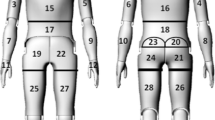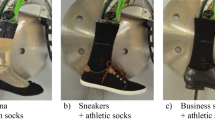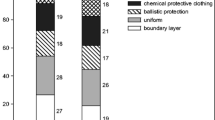Abstract
In this serial study, 486 thermal manikin tests were carried out to examine the effects of air velocity and walking speed on both total and local clothing thermal insulations. Seventeen clothing ensembles with different layers (i.e., one, two, or three layers) were selected for the study. Three different wind speeds (0.15, 1.55, 4.0 m/s) and three levels of walking speed (0, 0.75, 1.2 m/s) were chosen. Thus, there are totally nine different testing conditions. The clothing total insulation and local clothing insulation at different body parts under those nine conditions were determined. In part I, empirical equations for estimating total resultant clothing insulation as a function of the static thermal insulation, relative air velocity, and walking speed were developed. In part II, the local thermal insulation of various garments was analyzed and correction equations on local resultant insulation for each body part were developed. This study provides critical database for potential applications in thermal comfort study, modeling of human thermal strain, and functional clothing design and engineering.









Similar content being viewed by others
References
ASTM F2370 (2010) Standard test method for measuring the evaporative resistance of clothing using a sweating manikin. American Society for Testing and Materials, West Conshohocken
Belding HS, Russell HD, Darling RC, Folk GE (1947) Analysis of factors concerned in maintaining energy balance for dressed men in extreme cold: effects of activity on the protective value and comfort of an arctic uniform. Am J Physiol 49:223–239
Bouskill LM, Havenith G, Kuklane K, Parsons KC, Withey WR (2002) Relationship between clothing ventilation and thermal insulation. Am Ind Hyg Assoc J 63:262–268
Breckenridge JR (1977) Effects of body motion on convective and evaporative heat exchanges through various designs of clothing vol Clothing Comfort. Ann Arbor Science, Ann Arbor
Dai XQ, Havenith G (2009) Effect of clothing ventilation on thermal insulation and vapor resistance. Proceedings of the 13th International Conference on Environmental Ergonomics. Boston, Massachusetts, USA, pp 83–87
Gagge AP, Burton AC, Bazett HC (1941) A practical system of units for the description of the heat exchange in man with his thermal environment. Science 94:428–430
Havenith G, Nilsson HO (2004) Correction of clothing insulation for movement and wind effects, a meta-analysis. Eur J Appl Physiol 92:636–640
Havenith G, Heus R, Lotens WA (1990) Resultant clothing insulation: a function of body movement, posture, wind, clothing fit, and ensemble thickness. Ergonomics 33:67–84
Havenith G, Zhang P, Hatcher K, Daanen H (2010) Comparison of two tracer gas dilution methods for the determination of clothing ventilation and of vapour resistance. Ergonomics 53:548–558
Holmér I, Nilsson H, Havenith G, Parsons K (1999) Clothing convective heat exchange—proposal for improved prediction in standards and models. Ann Occup Hyg 43:329–337
ISO 11079 (2007) Evaluation of cold environments—determination of required clothing insulation (IREQ). International Organization for Standardization, Geneva
ISO 15831 (2004) Clothing—physiological effects—measurement of thermal insulation by means of a thermal manikin. International Organization for Standardization, Geneva
ISO 7730 (2005) Moderate thermal environments—determination of the PMV and PPD indices and specification of the conditions for thermal comfort. International Organization for Standardization, Geneva
ISO 7933 (2004) Ergonomics of the thermal environment—analytical determination and interpretation of heat stress using calculation of the predicted heat strain. International Organization for Standardization, Geneva
ISO 9920 (2007) Ergonomics of the thermal environment—estimation of the thermal insulation and evaporative resistance of a clothing ensemble. International Organization for Standardization, Geneva
Kim CS, McCullough EA (2000) Static and dynamic insulation values for cold-weather protective clothing. In: Nelson CN, Henry NW (eds) ) Performance of protective clothing: issues and priorities for the 21st century, vol 7. ASTM STP 1386. American Society for Testing and Materials, Conshohocken, pp 233–247
McCullough EA, Kim CS (1996) Insulation values for cold weather clothing under static and dynamic conditions. Environmental ergonomics-recent progress and new frontiers. Freund Publishing House, London
Morrissey MP, Rossi RM (2014) The effect of wind, body movement and garment adjustments on the effective thermal resistance of clothing with low and high air permeability insulation. Text Res J 84:583–592
Nielsen R, Olesen BW, Fanger PO (1985) Effect of physical activity and air velocity on the thermal insulation of clothing. Ergonomics 28:1617–1631
Nilsson HO, Holmér I (1997) Development and clothing measurements methods with the thermal manikin TORE. In: Proceedings of the 5th Scandinavian Symposium on Protective Clothing, Danish Work Environment Fund, Elsinore, pp 30–35
Nilsson HO, Anttonen H, Holmér I (2000) New algorithms for prediction of wind on cold protective clothing. In: NOKOBETEF 6, the 1st European Conference on Protective Clothing, Norra Latin, Stockholm, Sweden, pp 17–20
Nishi Y, Gonzales RR, Gagge AP (1975) Direct measurement of clothing heat transfer properties during sensible and insensible heat exchange with thermal environment. ASHRAE Trans 81:183–199
Oguro M, Arens E, de Dear R, Zhang H, Katayama T (2001) Evaluation of the effect of air flow on clothing insulation and total heat transfer coefficient for each part of the clothed human body. J Archit Plan Environ Eng AIJ 549:13–21
Olesen BW, Sliwinska E, Madsen TL, Fanger PO (1982) Effect of body posture and activity on the thermal insulation of clothing. Measurement by a movable thermal manikin. ASHRAE Trans 88:791–805
Tanabe S, Kobayashi K, Nakano J, Ozeki Y, Konishi M (2002) Evaluation of thermal comfort using combined multi-node thermoregulation (65MN) and radiation models and computational fluid dynamics (CFD). Energy Build 34:637–646
Vogt JJ, Meyer JP, Candas V, Libert LP, Sagot JC (1983) Pumping effect on thermal insulation of clothing worn by human subjects. Ergonomics 26:963–974
Wan X, Fan J (2008) A transient thermal model of the human body–clothing–environment system. J Therm Biol 33:87–97
Wang F, Kuklane K, Gao C, Holmér I (2010) Development and validity of a universal empirical equation to predict skin surface temperature on thermal manikins. J Therm Biol 35:197–203
Wang F, Gao C, Kuklane K, Holmér I (2011) Determination of clothing evaporative resistance on a sweating thermal manikin in an isothermal condition: heat loss method or mass loss method? Ann Occup Hyg 55:775–783
Acknowledgments
This study was financially supported by projects from the Natural Science Foundation of Jiangsu Province (project no. BK20130312), the China Postdoctoral Science Foundation (project no. 2014 M551657), the Natural Science Research Project for Colleges and Universities in Jiangsu Province (project no. 14KJB540001), and the National Natural Science Foundation of China (project no. 51106021).
Author information
Authors and Affiliations
Corresponding author
Rights and permissions
About this article
Cite this article
Lu, Y., Wang, F., Wan, X. et al. Clothing resultant thermal insulation determined on a movable thermal manikin. Part I: effects of wind and body movement on total insulation. Int J Biometeorol 59, 1475–1486 (2015). https://doi.org/10.1007/s00484-015-0958-1
Received:
Revised:
Accepted:
Published:
Issue Date:
DOI: https://doi.org/10.1007/s00484-015-0958-1




